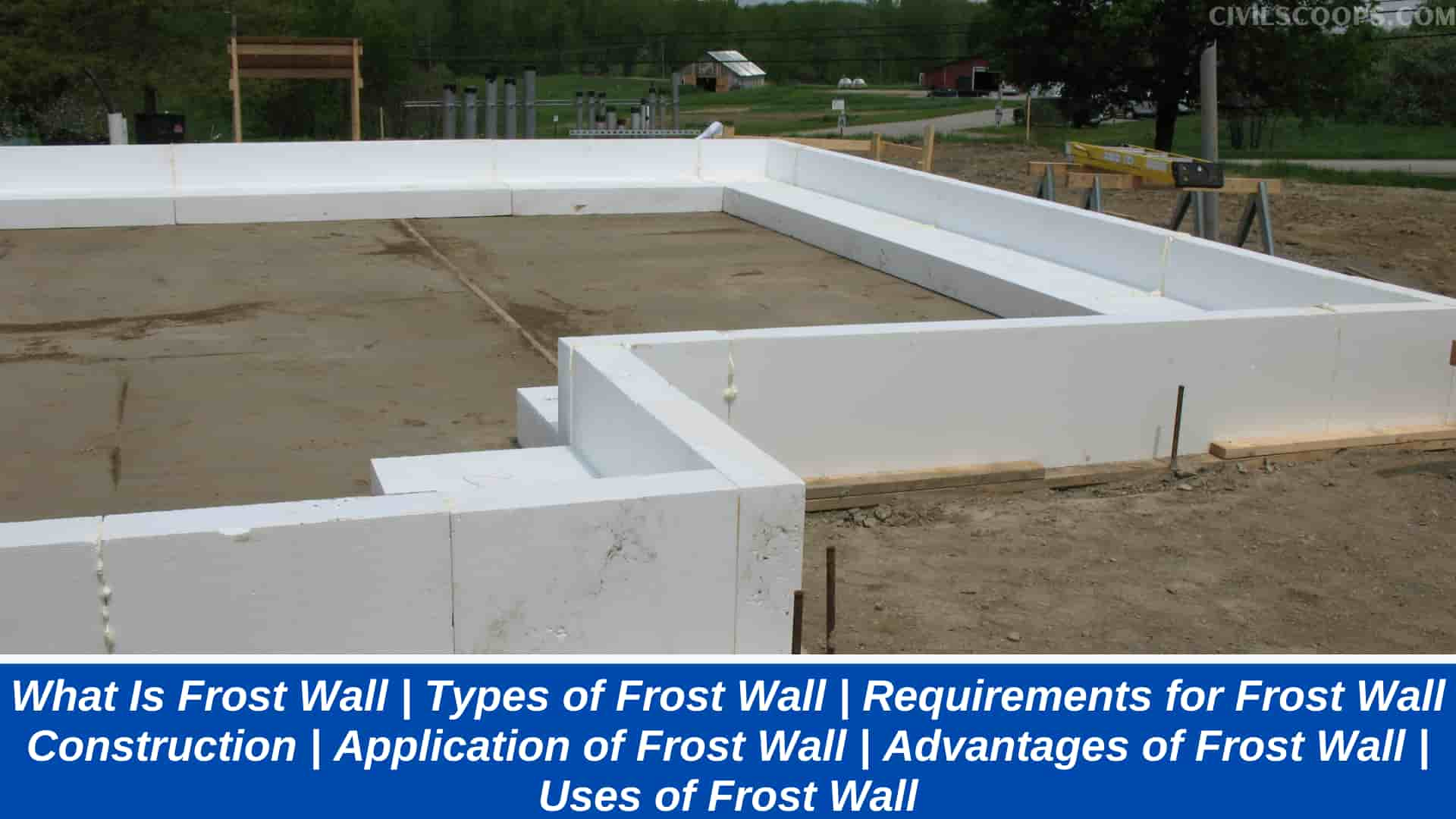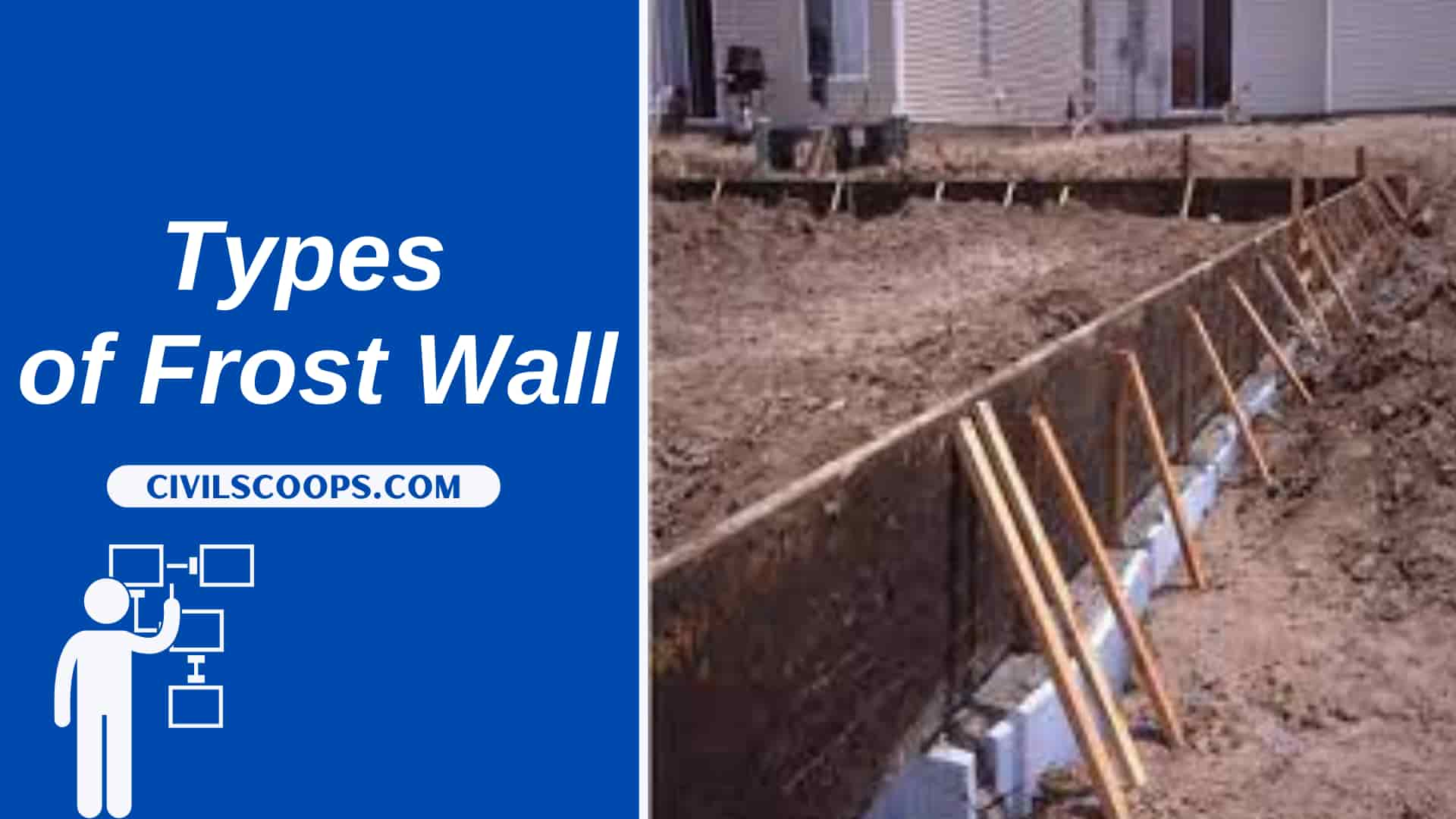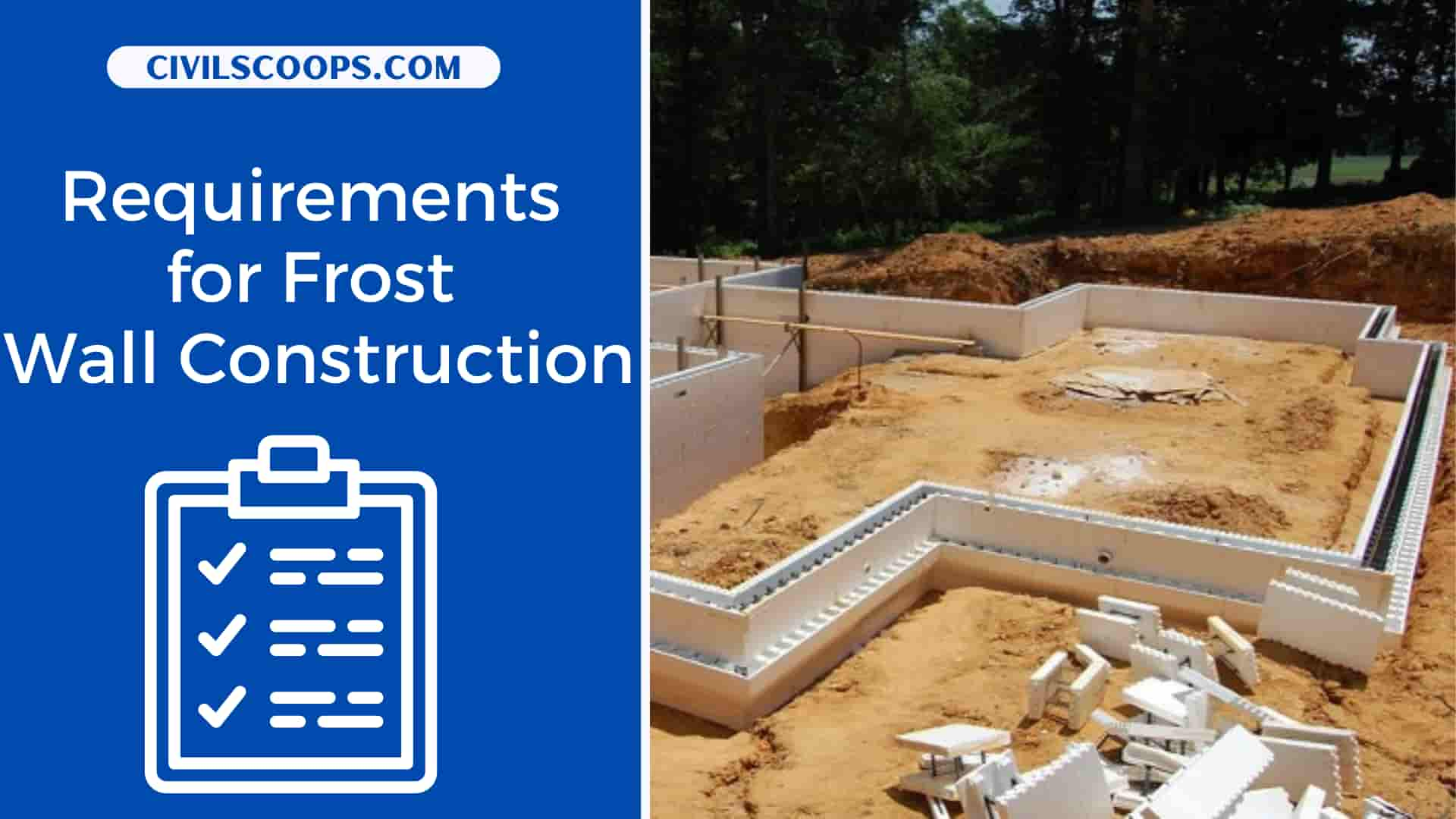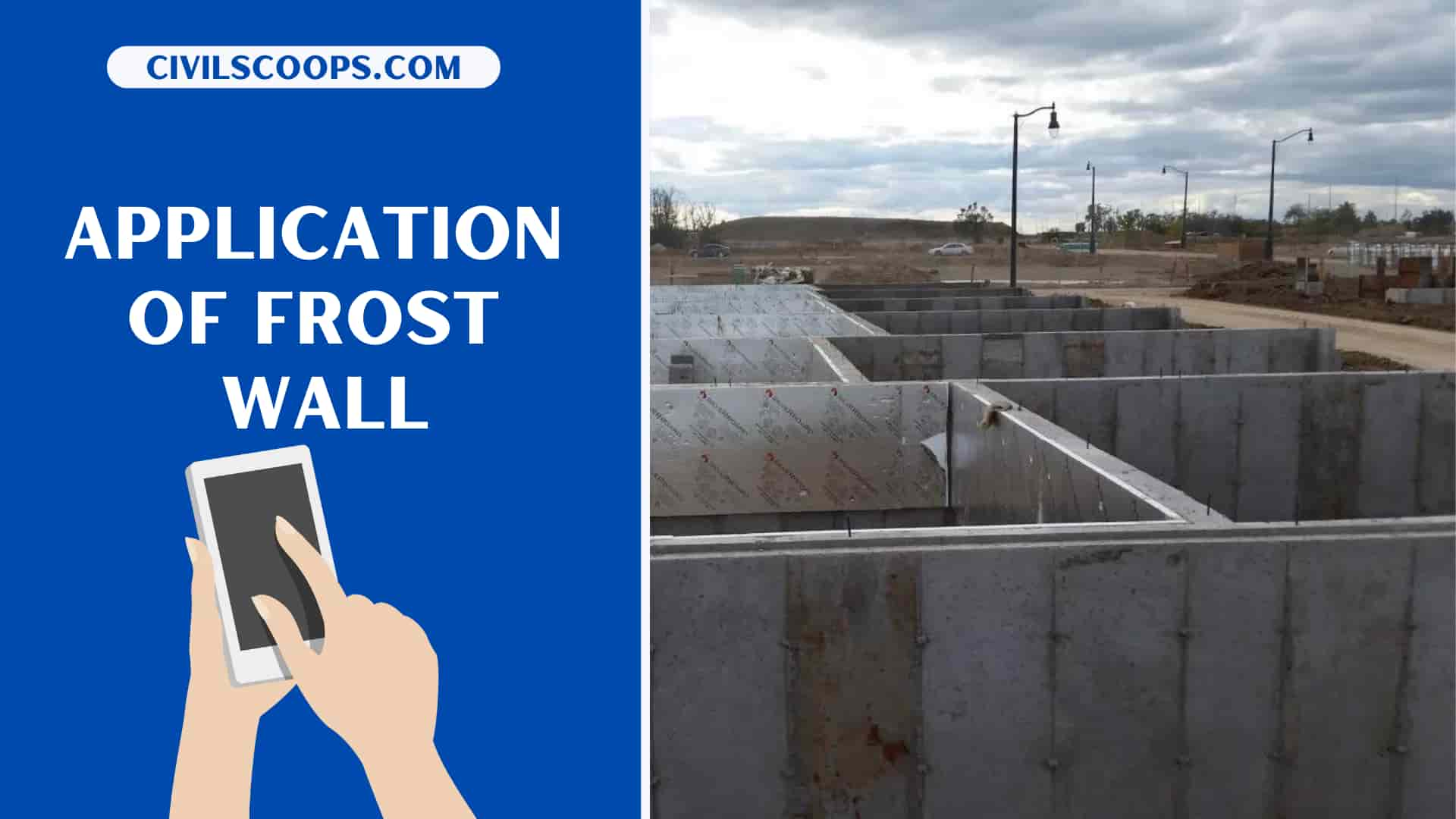What Is Frost Wall | Types of Frost Wall | Requirements for Frost Wall Construction | Application of Frost Wall | Advantages of Frost Wall | Uses of Frost Wall

Table of Contents
What Is Frost Wall?
The Frost wall or frost-protected wall structure is built to keep soil below the building against freezing to secure the foundations in freezing conditions. The Types of frost walls, their specifications, and applications are addressed. The frosting is a significant problem for buildings in colder climates. These undesirable results are more prominent and thus detected on the base of the house.
Any damage to the structural foundation would have an effect on the overall integrity of the construction. In regions where frosting is a recurring problem, the most common solution is to create a deep base that will lay well below the frost line above the ground surface.
The design of buildings and structural components in extreme climates is therefore a very difficult process. The temperature properties of the building materials used for the construction are the only influences that affect the construction process. The Concrete positioning and mixing in a cooler environment results in a contraction of the mixture. This concrete contraction can result in internal tension.
When these problems of contraction as well as internal tension are not treated seriously, there will be severe issues of internal pressure. The accumulation of internal stresses is a significant challenge to the structural stability including serviceability of the structure.
The frost wall could be described as an insulated wall built across the periphery of the foundation. They are built deep beneath the frost line. Even as frost wall is put under the earth, the base will not be exposed to an upward pressure from of the frost heave method.
The word frost wall is often used to refer to walls that are built above the ground in the interior of the building system. This will therefore serve as insulation to preserve the temperature of the interior of the house. These frost walls often absorb heat from its structure to keep the building’s underlying soil from freezing as well as related conditions.
Need for Frost Protected Wall
- The Frost protected wall is built to keep soil inside the structure from freezing at extreme cold conditions. A type of heat transformation is being used to move from its building to the ground below such that the ground doesn’t really freeze.
- Although they learned from the fundamentals of soil mechanics, the soil matrix is composed of voids filled by air and water. Such soil voids can be filled with air in dry soil. Throughout the situation of saturated soils, the voids would be flooded with water and will be turned to ice at freezing temperatures. The amount of water in the vacuum will rise as the water is turned to ice.
- The ground below the base are often packed with water. If the building is in a colder area, these waters would be turned into ice. Any decrease in temperature would dissolve the ice into the sea. As a result, the freezing and thawing procedure is observed. This would result in an upward display of the system due to expansion and contraction.
- With the reduction of soil water to ice, this frost-heavy phenomenon will increase. The ice in the soil is known to be an ice mirror. Such ice lenses are going to move the mixture of the underlying soil extensively. Any device existing on this increased soil will push the mechanism in the upward direction.
- Therefore, the only way to eliminate those problems is to provide a means to escape the freezing of the soil. The frost wall is such a special technique that has been commonly used for this reason.
Types of Frost Wall

Depending on the load, temperature including building characteristics specifications, there have been various types of frost walls which can be built. One such grouping is as follows:
- Load Bearing Frost Walls.
- Non-Load Bearing Frost Walls.
1. Load Bearing Frost Wall.
This frost wall construction would put the burden of the base above the frost wall. The frost wall itself would serve as a base wall, building it under the earth. This is obviously going to be built under the frost line of the town. These types of frost walls are built in harsh weather conditions (freezing temperatures).
2. Non–Load Bearing Frost Wall.
Even as title indicates, such frost walls are formed much like an insulating wall. It’s built in homes that are not enclosed. These insulated non-load bearing walls would be installed within the house.
No – Filling frost walls helps prevent heat from escaping into the base. The designed inner frost wall should not be in contact with the surrounding wall. Extra caution should be taken before designing the same item.
The distance between the two walls is preserved. It is therefore advised to provide a membrane to deter precipitation, otherwise, the moisture would be turned into ice inside the wall structure.
Requirements for Frost Wall Construction

The structure of the frost wall offers improved results if all the structural elements that follow this construction will be of the necessary resources.
Any of the core functions relating to its specifications are set out below:
- In order to eliminate any exposed holes, the cellar wall under the wall must be patched.
- Often, such basement walls are built only with aid of cinder blocks. Mostly with support of brick fillers, the holes may be filled.
- Unless the basement walls are made of concrete, every gaps found in it must be cleared by means of a paint sealer.
- Unique paints are present on the market that can help stop moisture from entering the basement. Both structural components must be designed with the primary purpose of avoiding the intrusion of moisture.
How Deep Is Frost Line?
The frost line, often recognized as frost depth or freezing depth is quite generally the depth where the groundwater is supposed to freeze in the soil.
The extent of the frost relies on the atmospheric conditions of the region, the heat transfer property of the soil as well as the neighboring materials as well as the surrounding flammable substances. That path differs in latitude, which is nearer to the poles. According to Federal Highway Administration Publication , the mean depth of frost recorded in neighbouring United States varies from zero to 8 feet .
The temperatures ranging that below depth, and is still over 32 °F (0 °C).
How to Determine Frost Line?
- The extent of the frost relies on the climatic conditions of the region, the heat transfer properties of the soil as well as the neighboring materials as well as the surrounding sources of heat.
- Depth of freezing and thawing depends greatly on the degree and length of the temperature difference higher or lower freezing (32 °F) on the surface of the ground. The freezing as well as thawing value is then determined by summing the degree-days for both the freezing or thawing period.
Application of Frost Wall

Here are the works and installation of the frost wall to avoid the freezing of the shallow base and that of the non-heated structures.
Frost Wall for protection of Shallow Foundation.
- The frost wall built with an aim to secure the shallow establishment is non-bearing frost walls. This sort is utilized where the frost wall development as a profound establishment isn’t at all plausible for the territory or it doesn’t bring such an economy.
- The frost wall here is built by leaving a predefined hole according to the constructor suggestion with the establishment. This is orchestrated a particularly that the dirt doesn’t lose the warmth from it.
- Such forms of frost wall architecture are built around the base in such a manner which the heat absorbed form of the structure is effectively insulated.
- A dense insulation foam is built vertically on the outside of the structure and horizontally with the basement of the foundation. The structure of this insulation allows the heat formed inside the building to travel down the ground and keep this from freezing.
Frost Wall for Non-Heated Buildings
- The frost wall described earlier offers energy to the building unless the building is a hot building. That sort of frost wall would not work for the unheated type of house.
- An option to this is the construction of a horizontal layer put beneath the base of the whole house. Such horizontal layer must also be stretched outwards across the construction sector. No type of vertical insulation is given.
- The insulation given is spread on a sheet of gravel. Therefore, the heat is absorbed inside the soil as well as prevents the soil from freezing.
Advantages of Frost Wall
Heat loss through the building’s foundation helps prevent the ground beneath from freezing and heaving. In combination with geothermal heat stores, an FPSF installation allows soil below the foundation to remain above freezing even in extreme winters.
Also Read: What Is Foundation | What Is Purpose of Providing Foundation | Types of Foundation
Uses of Frost Wall
Frost wall or frost-protected wall construction is to prevent soil beneath the building from freezing for protection of foundations in freezing temperature climates. Types of frost walls, their requirements, and uses are discussed. The frosting is a serious issue for the building structures during colder climates.
[su_box title=”FAQ” style=”default” box_color=”#333333″ title_color=”#FFFFFF” radius=”3″ class=”” id=””]
Frost Wall
A frost wall is a structure that extends below the frost line to help insulate the ground beneath a building’s foundation. Two main types of frost walls exist with slightly different purposes: load bearing and non-load bearing frost walls.
Definition Frost Wall
The frost wall can be defined as an insulated wall that are constructed around the periphery of the foundation. These are constructed deep and beneath the frost line. The term frost wall is also used to mention walls that are constructed above the ground in the interior of the building structure.
What Is Frost Wall?
Frost walls are concrete walls that are placed in the ground deep enough so that in the cold of winter when the ground freezes the walls and the footings they are sitting on will not end up with the ground freezing underneath them. Frost walls are not expensive; they are a 4 ft high concrete wall sitting on a footing.
Need for Frost Protected Wall
Frost protected wall is constructed with an intention to prevent the soil around the building from freezing under high freezing temperatures. A form of heat conversion is used to transfer from the building to the soil beneath so that the soil does not freeze.
How Deep Is Frost Line in Construction?
Frost lines vary by latitude and are deeper closer to the poles. In the contiguous United States, according to the Federal Highway Administration, the maximum frost depth ranges between zero to eight feet. Frost lines can be important for building construction and are taken into consideration when laying a foundation.
Frost Wall Concrete
Frost walls are concrete walls that are placed in the ground deep enough so that in the cold of winter when the ground freezes the walls and the footings they are sitting on will not end up with the ground freezing underneath them. Frost walls are not expensive; they are a 4 ft high concrete wall sitting on a footing.
Frost Wall Cost
The price of a frost-protected shallow foundation is $8 to $12 sq.ft. Frost-protected foundations are similar to slab-on-grade but insulated with rigid polystyrene beneath the foundation. These may be poured at once like regular monolithic ones but work in areas where the ground freezes.
Concrete Frost Wall Thickness
As a practical consideration, residential designers need to keep in mind that concrete foundation walls are typically 6, 8 or 10 inches thick (nominal). The typical concrete compressive strength used in residential construction is 2,500 or 3,000 psi, although other strengths are available.
Frost Wall Vs Foundation
The frost wall can be defined as an insulated wall that are constructed around the periphery of the foundation. These are constructed deep and beneath the frost line. As the frost wall are placed beneath the soil, the foundation won’t be subjected to upward pressure from the frost heave process.
Slab with Frost Wall
So-called frost-protected shallow foundations usually consist of a monolithic (thick-edged) slab wrapped with vertical and horizontal rigid-foam insulation.
How Deep Is a Frost Wall?
In the US, common frost depths range from 12 inches in southern states (some with no requirements for frost) to 4 feet in more northern states. In fact, Canada and Alaska have even deeper frost lines.
Frost Walls for Garage
This type of foundation is built using a continuous footing that is set below frost level. A continuous concrete wall is then built on top of the footing that will be exposed above finished ground level 12″ for water protection.
[/su_box]
[su_note note_color=”#F2F2F2 ” text_color=”#333333″ radius=”3″ class=”” id=””]
Like this post? Share it with your friends!
Suggested Read –
- What Is a Spillway | Types of Spillway | Definition Spillway | Spillway Design
- What Is Workability | What Is Workability of Concrete | Types of Workability of Concrete | Factors Affecting Workability of Concrete
- What Is Sewerage System? | Types of Sewerage System | Why We Need a Partially Separate System? | How Does a Sewer System Work? | How Does a Sewage Treatment Plant Work?
- What Is Seasoning of Timber? | Methods of Seasoning of Timber | Purpose of Seasoning of Timber
- What Is Gradient of Road? | Limiting Gradient of Road | Types of Gradient of Road | Exceptional Gradient of Road | The Gradient of Road | Purpose of Providing Gradient of Road | Importance of Gradient in Roads
[/su_note]
Originally posted 2022-07-22 10:26:08.
